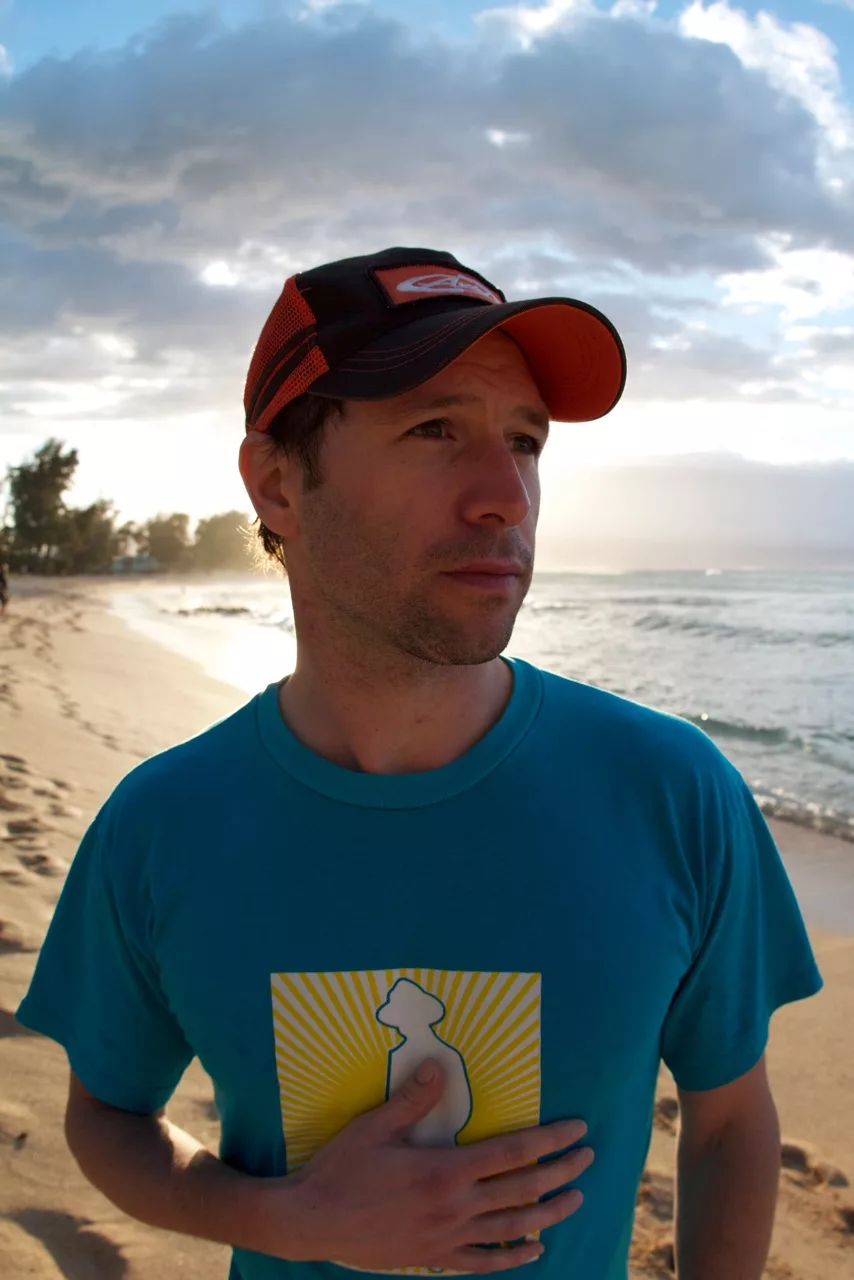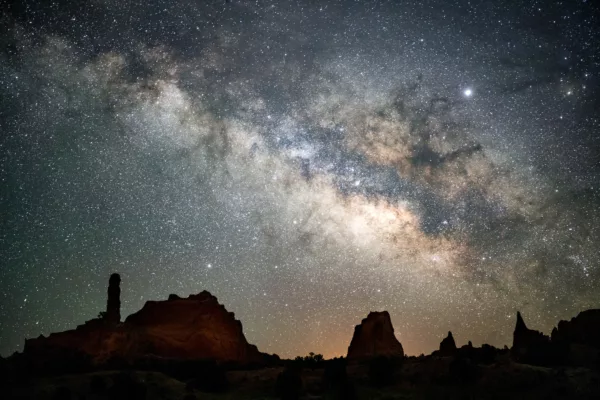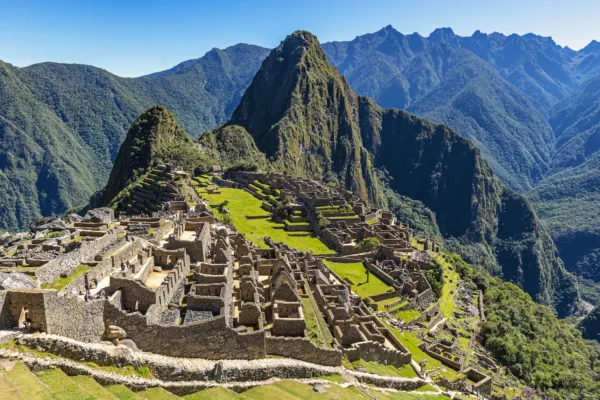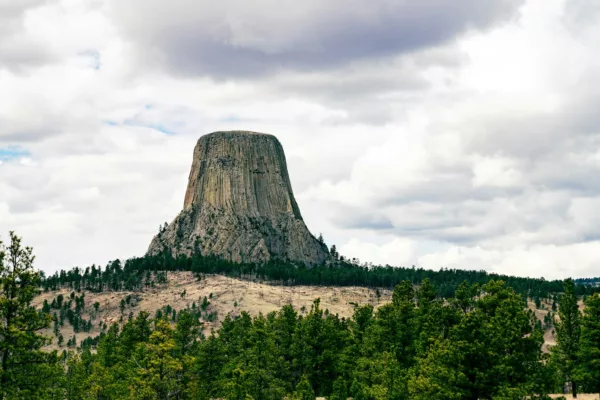This Rocky Mountain Horseback Adventure Should Be On Your Bucket List
Not much scares Dee Barrus. So when he yells “Get the hell out of here!” you do just that.
We were at the tail end of our last trail ride of the week, the home stretch. That morning we led our horses across short-grass prairie right at the foot of the Rocky Mountains. Without a trail, fence, road or anything manmade in sight, I enjoyed a sense of what it must have been like for explorers or cowboys riding in Alberta more than 100 years ago. After that buzz of satisfaction I was now in a hungover bliss, just enjoying the last hour on a horse. Barrus led us across a creek, up a short hill and onto a singletrack trail through a dense stand of poplar trembling in the wind. Like we’d seen everywhere in the lowlands of Waterton Lakes National Park, the area was thick with Saskatoon berry bushes, drooping under the weight of a wholesome crop and mangled in the haste of gorging bears. On the first three-hour ride of the weeklong Trail Riders of the Canadian Rockies camp, the group had seen nine bears, both grizzlies and blacks.
So a bear on the trail came as no surprise. And Barrus looked anything but worried as he paused the group to scare her off. (Bears tend to avoid large groups and horses; we were both.) A minute later, the bear disappeared down the trail, he gave the go ahead and the train of city slickers followed. Mid-pack, I was in the perfect position to see two cubs shoot up a tree and look down on us quizzically. Almost at the same time, Barrus started shouting again—I recognized it as “go away bear” noises. Then it changed to something else. Something more fearful. In the excitement of seeing bear cubs up a tree and Barrus yelling obscenities at an angry momma, it took everyone a few seconds to realize what was going on. And it took me just a bit longer than everyone else.

Suddenly, six horses and their riders were facing me and yelling to spin around. I felt like I had just turned the wrong way down a one-way road. Or, from the looks on their faces, I was the guy blocking the door of a burning house. My mind realized what was going on, but my body didn’t know what to do. For one thing, I was on a horse. Telling a horse what to do was anything but instinctual. For another, I was at the narrowest point in the trail, a choke between poplars just a little wider than my horse’s substantial hind end. There was no way an equine-sized body could spin on the spot. For the first time in three days I wondered, “What the heck am I doing on a horse?”
I’m not a horse guy, though while still admiring me from afar my wife thought I was a
rodeo star. Her brother and my boss at an outdoor education centre on Vancouver Island, British Columbia, had told her that lie. Because I was from Alberta and often had a sunburned neck, she believed it. In reality, I grew up in cities, was more into self-propelled stuff and was kind of scared of horses, despite a long family history with our hoofed friends.
That history traces its roots back more than 90 years, with a group of horseback riders snowbound in Wolverine Pass along Kootenay National Park’s Rockwall Trail. Stuck in a tent for three days, but enthralled with the riding up until then and wanting to share it with the world, they developed the idea of the Trail Riders of the Canadian Rockies. The next summer, in 1924, the Trail Riders struck their first camp in the Yoho Valley of Yoho National Park. With support of the Canadian Pacific Railway, city slickers hopped the train to Field and then rode into a camp near Takakkaw Falls. Sleeping in teepees, they day-tripped by horseback into the mountains. At night, a piano hauled into the valley by horseback entertained the riders. It was a success and every summer since the Trail Riders have repeated the weeklong camps, but in a different area of Canada’s mountain national parks. (The Trail Riders established many of the hiking trails cut in the parks.) Soon, riders were coming back every year to see new country they probably couldn’t reach on their own, spend time on a horse and, maybe most of all, to hang out around a campfire with friends.
A friend of my grandfather’s helped run the Trail Riders in the 1950s. One summer, when my mom was still a little kid growing up in Calgary, he asked my grampa, a talented accordion player, to volunteer as the Trail Ride musician for the week.
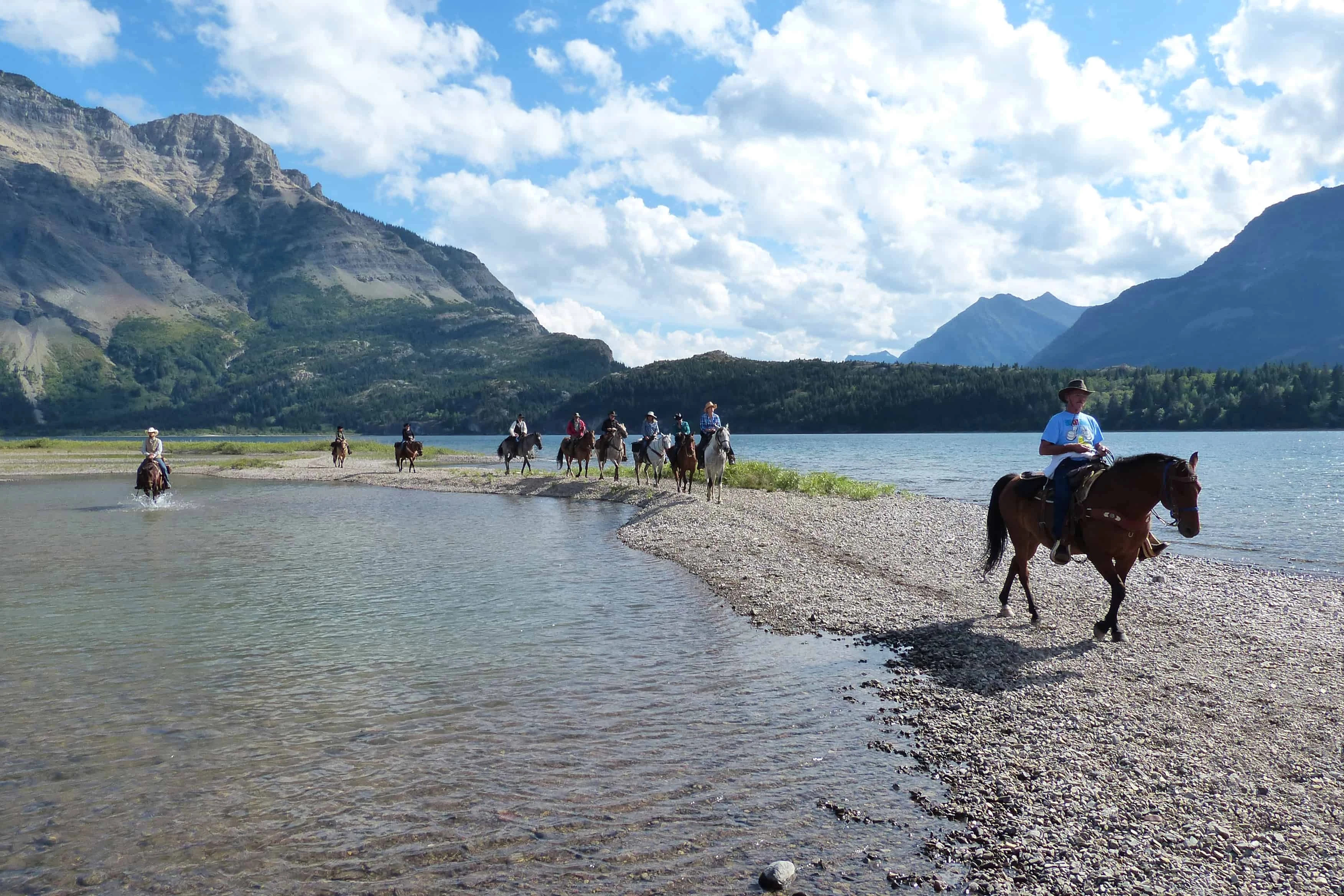
Grampa wasn’t particularly keen on horses, nor mountains, but something about the invitation grabbed him. My mom guesses he signed on for the social aspect—his week away every summer. And he loved it. Grandpa had been going on a trail ride every summer for about a decade by the time my mom and her sister were 15. The Beatles were playing in Seattle that summer and as twin teenagers in the 1960s they “had to go.” The idea appalled my grandparents, so they offered the girls an alternative option—why don’t they come on the Trail Ride instead? It worked. They rode into the backcountry camp, shared a teepee, rode horses every day and discovered what their dad had been doing all those weeks away.
“Every night he’d take out his flask of rum, mix it with fruit punch because there was no Coke, and go chat with people around the campfire,” my mom remembers. “Then after dinner, he’d take out his accordion and play.”
The sisters went back for several more summers and one year my mom washed dishes. When I was in elementary school, she worked for the non-profit, booking rides from an office in our Calgary basement. In 1984, she and my dad abandoned their three kids—on my birthday!—to join the 60th anniversary ride, a weeklong trek from Banff to Jasper. The adventure and camaraderie promised by the Trail Riders was branded in my mind. But even a brand needs tending.

As a kid, I went to a horse camp one summer. My mom’s sister owned a few horses and when we visited we’d often go for rides across the farmland. I also remember her and my uncle taking us on a ride in Banff National Park, but what sticks out from that day are the mountain bikers we saw on the trail. That looked like fun. By the time I was a teenager, horses were boring—I’d rather be skiing, climbing, paddling or mountain biking. And it stayed that way right up until last summer. Out of the blue I was offered a spot at a Trail Riders of the Canadian Rockies camp. I thought about my family history, about riding into the mountains and then about how much Paige, my 12-year-old daughter, would like it. When I found I could bring her along, I signed us up for a three-day trip.
“I’m pretty sure you’re the first four-generation family on a Trail Ride,” says Stuart Watkins, the TRCR’s president. It’s the evening after our first ride and we’re sitting in the dining tent waiting for the dinner bell. Despite the soaking rain, that day had been a perfect intro for Paige and me.
We showed up at the stable that morning feeling a little nervous; butterflies in my stomach and Paige’s silence giving the emotions away. But once I patted my assigned horse—a chestnut brown sweetheart—I immediately calmed. She turned her head my way and nuzzled into a scratch between the eyes. Paige was equally enamoured with her horse, a mellow fellow. Both are classic trail horses, explains Josh Watson, Dee Barrus’s grandson and our guide for the day. We’re 15 minutes into the ride when a deer proves his point. It erupts from almost underneath our horses, scaring us all. The horses only flinch. I quickly get the feeling that I could do nothing and my horse would stay the course.

Slowly, I relax and stop trying to micro-steer, letting the horse pick its way along the trail. Not having to look where I’m stepping, like I would if I were hiking, my eyes lift from the ground and start scanning the trees, mountains and sides of the trail. We spot the skeleton of an elk, a few metres off-trail and out of sight to most walkers. A trampled tunnel of grass gives away a beaver slide. I notice all kinds of animal tracks in the trailside mud. Snatching berries from the top of a trail-side bush is easy. It reminds me of the difference between sitting in a kayak and being on a stand-up paddleboard—horseback provides a new perspective on the same scene.
After the ride, we returned to the trail ride camp. Just outside of the park border, the camp is a collection of canvas sleeping tents and teepees with cots, a spacious dining tent, a couple of outhouses and an outdoor propane-powered shower. It’s rustic comfort.
I’m sitting with Watkins, getting cozy next to a woodstove when the dinner bell rings. First we slurp split-pea soup, then dig into roast beef, potatoes, veggies and chunky gravy. Just when I think I’m absolutely stuffed, the cooks pull out Saskatoon berry pie. I manage to find a little more room. Every dinner is like this.
“More than anything, the Trail Rider experience is a cultural one,” Watkins says, scraping his bowl clean. “It’s a connection to the past. To the way the mountains were explored and the West was settled.”

And then in walks a living specimen.
Dee Barrus founded and still runs Alpine Stables, the outfitter for the TRCR in Waterton. At 82, he figures he’s ridden around the world five times on horseback. As he sits down in front of our group of 11 riders to tell us a couple of stories—tonight’s evening entertainment—and I can’t help comparing him to Curly from the movie City Slickers. He looks a bit like him with white hair, plenty of wrinkles and bowed stance— “I’m five foot seven and shrinking,” he says. But unlike the crusty cowboy who taught Billy Crystal the meaning of life, Barrus is the real deal. He grew up on a ranch. Just getting to school as a kid meant riding five kilometres each way. He still runs three traplines during the winter and hops in and out of a saddle faster than I do, even with a still-healing dislocated shoulder and hands that are frustratingly stiff. Nothing slows him down as he keeps his stable humming, loads horses into trailers and leads our group into the mountains. Tonight, though, is about the past. He tells several good bear stories and wraps up with the reassurance that the bears in Waterton are generally easy-going.
Our second ride really shows the horse advantage over humans. We’re going to ride Avion Ridge, about a 30-kilometre round trip with 1,000 metres of elevation gain. I could imagine hiking that in a long, arduous day—but doing it with Paige would not be enjoyable for either of us. Instead we meet Watson, Barrus and our horses at the trailhead and begin a speedy and (almost) effortless walk up the valley. The first part of the trail is an old road, allowing me the chance to survey the group.
Of the 11 people on our trip, only one has ever done a trail ride before. This speaks to a trend Watkins has noticed. Where they used to have a 60 per cent return rate, today it is 15 per cent. “People tell us their trail ride was their greatest trip ever, but they aren’t coming back because they want to do something new every year,” says Watkins. “It’s bucket list travel.”

Combined with the rising cost of keeping horses, plus a week of trail riding, and the TRCR is hurting. Where they used to fill all 12 weeks of the summer with 30 riders or more, in 2016 they only ran three trips and none were full. Our three-day ride, rather than the typical week, is part of an effort to attract more riders. On our ride, half of the people have some history with horses: they grew up riding or own a horse today. The rest of us are inexperienced. The riders are teachers and lawyers, sales reps and university professors from Calgary, Niagara, Michigan and South Carolina. Making a quick judgment call, I’d guess none would hike Avion in a day.
“We take all kinds from all walks of life,” says Watkins. “The number-one reason they come is not the horses. They want to see the backcountry but they don’t want to walk. Unless you’re allergic or hurt you can ride a horse—and a horse can take you just about anywhere you can walk.”
This becomes obvious the higher we climb on Avion. The horses hop up rock steps, spin around switchbacks and plod through creek crossings. As the trail steepens, the horses start to sweat. I do not, the breeze whistling through the larch forest keeping me perfectly comfortable. Eventually, we break out of the forest and emerge on the ridge crest. The trail is exposed here and Paige is nervous. “I don’t want to go any farther,” she says.
Even though the drop is hundreds of metres and the horse adds inconsequential extra height, I understand where she’s coming from. Without my feet planted on the ground I don’t feel in control. I’m trusting my life to an animal. Josh Watson chuckles and puts us at ease. “Your horse doesn’t want to go down there even more than you don’t want to go down there,” he says.

The horses grind up the final scree slope and then we can’t go any higher. On one side, the slope rolls away ever steeper. On the other, it ends in a vertical drop. In between is just enough room to get out of the saddle and swing our feet over the edge. From this perch we look deep into Montana at Glacier National Park’s namesake icefields and pinnacle peaks. BC’s Flathead area is just over the ridge to our west. Waterton’s peaks and ridges of red, orange and grey rocks spider out around us in every direction. And through the valley below we can just see the edge of the prairie. This is an amazing spot and having the horses in the foreground only makes it seem more spectacular.
I grab Paige in a hug. She smiles with accomplishment just like she would if she’d hiked here; it’s the highlight of the trip for her. And then we both pat her horse, grateful for getting her to this spot. It feels way more satisfying than I thought it would to earn this summit without my own two feet.
I’m feeling like I earned it a few hours later as we trot down the trail. Sure the horse did all the heavy lifting, but right now the inside of my legs and my butt don’t feel that way. Eight hours in the saddle is helping me discover muscles I’ve never used before. Paige feels the same. She rides up next to me and quietly complains about how much her feet hurt. “We’re almost done,” I say in solidarity. It’s the first time she’s complained since we left home, a remarkable streak.

For our last ride—the one with the bears—we leave Alpine Stables and head overland along the base of the mountains. Rather than ride single-file, we spread out and pick our own route. The horses seem to self-segregate into cliques. I’m realizing they’re a lot like people. Each horse has its own personality and its own quirks. Paige’s horse didn’t like getting its feet wet and would leap any creek it could. Others want to be at the front of the pack. Some prefer the rear. They get cranky as they tire. And some just can’t stand being near each other. The ride is as memorable as Avion, but for different reasons. It feels liberating and wild to wander aimlessly.
Reluctantly, knowing the show is about to end, we loop back towards the stable. The horses can smell the oats. They’re moving with purpose when we end up between the momma bear and her cubs and I find myself jammed like a cork. I yank on the reins trying to back my horse out of the choke point. The horse’s ears turn backwards but she doesn’t move. I try kicking. The ears swivel. I’m flummoxed and start to panic. That’s when the horse takes matters into her own hoofs—spinning on the spot and charging down the trail, the rest of the group hot on her shoes.
“That momma bear was getting ready to charge,” Barrus tells us a few minutes later, as we gather in an open meadow safely out of her way. He’d never seen the cubs. “Another second and we would have been in trouble. I’m lucky she gave me another chance.” Any sign of fear is long gone from the cowboy’s face.
He leads us around a different way and far too soon we’re dismounting for the last time. I’m surprised to feel sad. I don’t know when I’ll be on a horse next. I’ve come to appreciate their value. I used to think the day I can’t hike into the mountains would be the last day I’d truly be alive, but now I see a glimmer of life after death.
Maybe one day, five generations of my family will trot into the mountains with the Trail Riders of the Canadian Rockies.
If You Go
Trail Riders of the Canadian Rockies packages start at $2,225, from Calgary. trailridevacations.com






